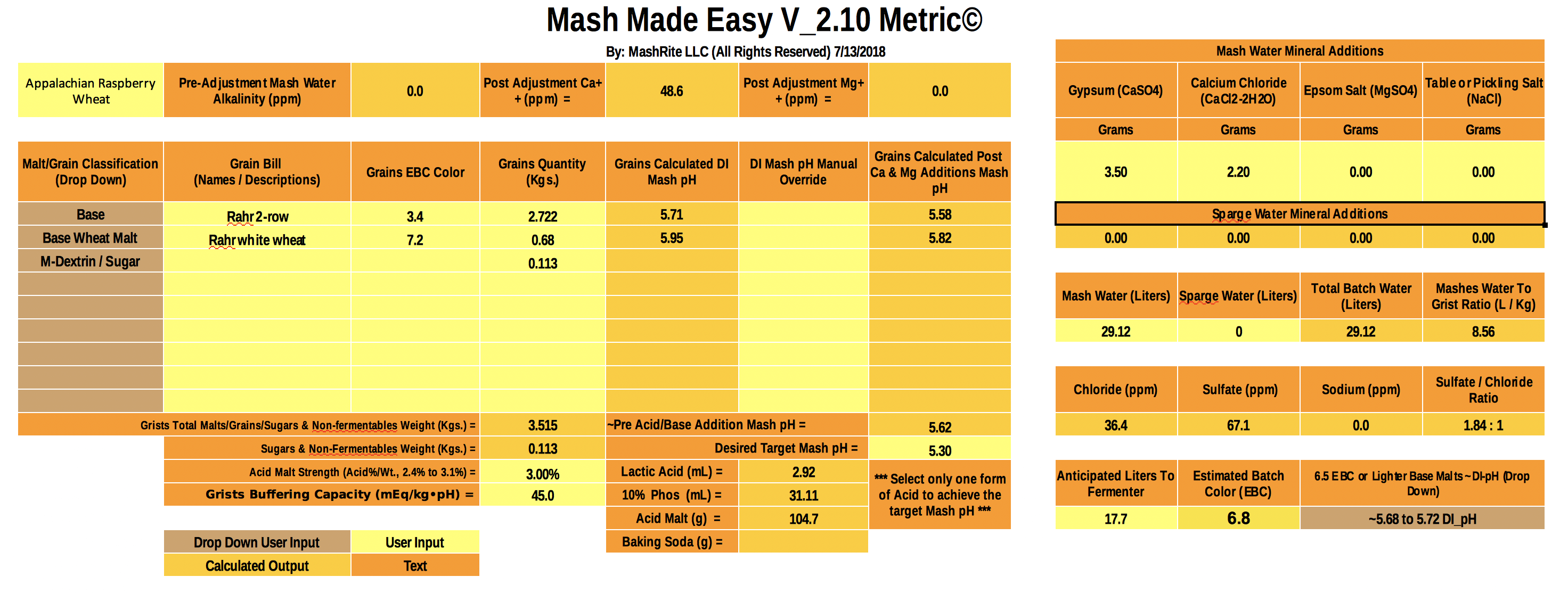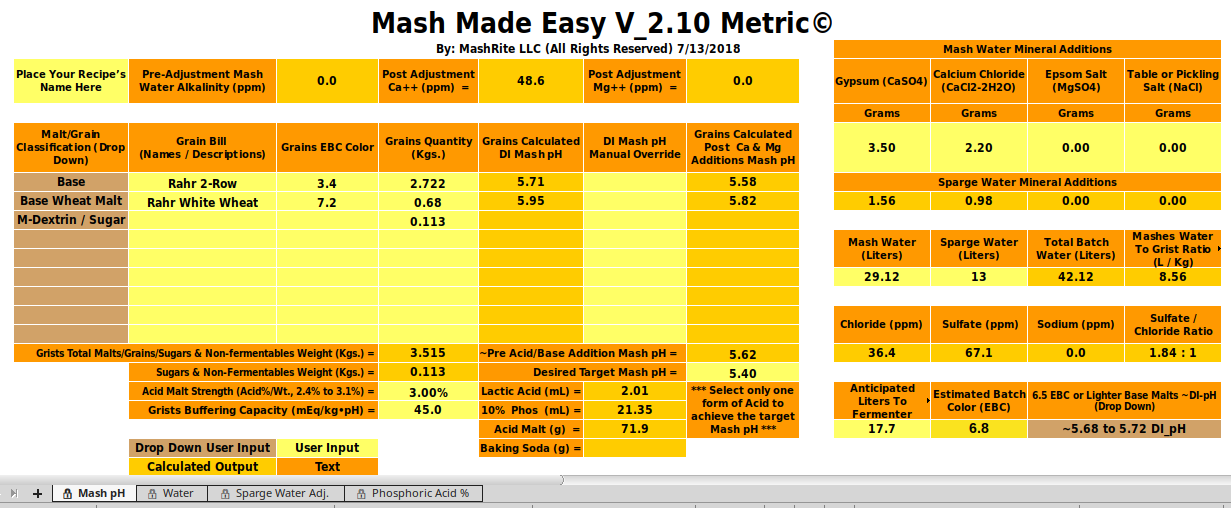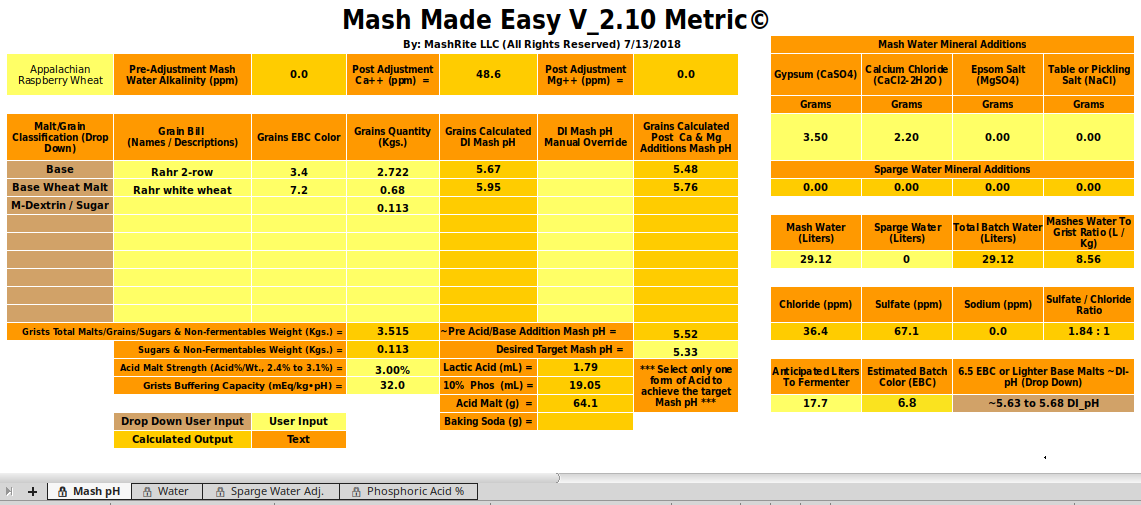- Joined
- Jul 28, 2013
- Messages
- 3,108
- Reaction score
- 5,569
Doh, I see that now. If the source water is RO, what would the suggested default values be for that on the water tab?

Doh, I see that now. If the source water is RO, what would the suggested default values be for that on the water tab?


Try as I may I was not able to get my copy to give lactic acid results as high as yours did, so I'm a bit confused as to what might be happening. Here is what I get simply by changing the DI_pH range for the Rahr via the lower right hand selector as I mentioned above. And if I change the buffer value to 32 the required acidity addition for 88% Lactic Acid is even lower than seen here, at only 1.15 mL. Do my input values match yours across the board?
View attachment 579270
17.7 anticipated liters to fermenter?

That only impacts the predicted color of the beer.
Ok, I have uploaded the spreadsheet -- you'll need to rename it back to Mash Made Easy 2.10 Metric.xlsx after you download it.
BTW, I am using LibreOffice on a Mac.
The only thing I would like added to MME is liquid calcium chloride.

What does DI mean? Like a definition?
How come cell H16 is always #NAME? in my v2.10 copy of MME? Examples shown on this thread have values in that cell. Mine does not.
I am running Apache Open Office Calc v. 4.1.5 released Dec 30, 2017, latest Java, under Windows 10.
Announcing the release of 'Mash Made Easy' version 2.20 in both the Standard and Metric formats.
Major changes include:
------------------------------
1: Improved model for buffering.
2) Acid Malt (also referred to as acidulated malt, or as Sauermalz), when added directly into your recipes grist as a Malt/Grain "drop down" selection now functions properly in conjunction with the strength values which you also input via the "% Acid Malt Strength" button. 3% should be a good nominal starting point for most acid malts concentration of lactic acid by weight. If your particular lot of acid malt is consistently giving you mash pH's on the low side of your target pH, you can work this percentage down to 2.4% as needed. Or select any strength ranging from 2.4% to 3%. Modern acidulated malt is effectively a low Lovibond color base malt that has been sprayed with lactic acid.
3) Baking soda additions now reflect quantities adjusted slightly to reflect A.J. DeLange's recent discovery (and his math model) of their nature (associated with baking soda being a weak base) within (and with respect to) the selected Target pH vicinity of mashes.
All users are advised to transition to this new version.
The problem I always had with Sauermalz is that to hit my numbers I often had to set the acid % to upwards of 6%. It wasn’t until A.J. pointed out that it doesn’t acidify like a Lactic that that made sense.
There are potentially two ways to understand your 6%. One would be to presume that your lot is weak and you need to double it, and the other (the more likely of the two) is to presume it to be way stronger than normal, and you have to cut it in half.
I followed the Kai Troester model for acid malt strength at 3% nominal in Mash Made Easy. I just edited my comments above for acid malt.
EDIT #2: It’s also important to note that it’s nominal Lactic acid % doesn’t come into play for Weyermann’s recommendations. They only state that 1% Sauermalz should yield a -0.1 pH Δ.
In the end, this is how Mash Made Easy models its acid malt, so regardless of how one perceives its acid nature (and we do perceive it differently), all is well. This simplistic pH drop to grist percent ratio is precisely why Weyermann is listed in my credits. Weyermann is to be trusted on this for their "nominal" (or nominal spec) lots of Sauermalz. This ratio corresponds to 3% acid malt strength in 'MME'.
Do you use Sauermalz much? I just want to make sure that you don’t have a latent issue in your sheet by recommending the percentages you use. Maybe allow the user to input a wider range (2-6% maybe?)
Are you implying by this that Weyermann's advice that 1% moves the pH downward by 0.1 point is not "generally" valid advice?
I'm aware that acid malt may have lot to lot strength consistency issues, but I've made MME conform to this Weyermann principle as the norm. If for some lots 1% moves the pH down by 0.2 points, then I will need to expand my range to 6% in a future upgrade release.
Not sure if this happened to anyone else with 2.3, but the tabs weren't showing. Not sure why the show sheet tabs was shut off for this file. So if you can't see the tabs, click File > Options > Advanced—in under Display options for this workbook—and then ensure that there is a check in the Show sheet tabs box.
Enter your email address to join: